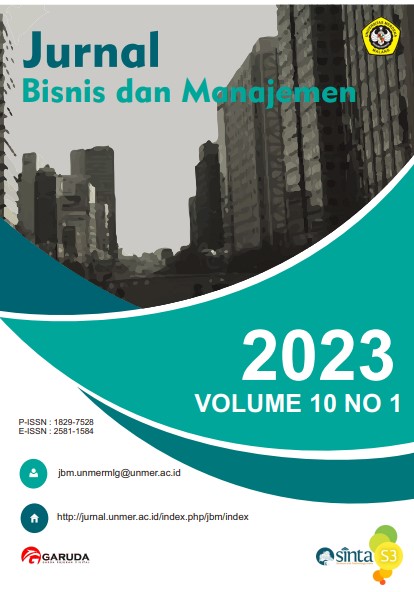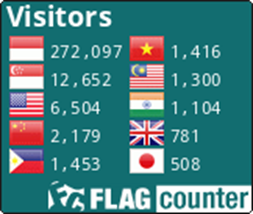Post-Pandemic Behavior: Continuance Intention of Baby Boomer and X Generation as New Users of Online Shopping Platforms during COVID-19
DOI:
https://doi.org/10.26905/jbm.v10i1.9241Keywords:
Post-Pandemic Behavior, Continuance Intention, Theory of Planned Behavior, Expectation-Confirmation TheoryAbstract
The Covid-19 pandemic has led to an unavoidable surge in the use of digital technology due to social restrictions and lockdowns. Various restrictions on activities during the COVID-19 quarantine period had resulted in many new users of digital services for daily activities and needs, including the elderly generation such as the X Generation and baby boomers, who before the pandemic were often considered as a generation that was difficult to accept technological change. In the midst of the COVID-19 pandemic, the baby boomers and X Generation have begun to adopt and use various digital applications, one of which is e-commerce, to make online purchases. With the return to the post-pandemic situation and routine, we wanted to test the continuance intention of X Generation and baby boomers in using e-commerce for online shopping. This study needs to be done since the data shows that the average number of online purchases issued by X Generation and baby boomers is greater than other generations. Unfortunately, the literature and previous research on the post-pandemic behavior of baby boomers and X generation for online shopping activities are still very limited, so this research is expected to contribute to a wider literature. The survey was conducted on 198 people aged 40-76 years who had made online purchases in e-commerce during the COVID-19 pandemic using Structural Equation Modeling.Downloads
References
Agag, G., Aboul-Dahab, S., Shehawy, Y. M., Alamoudi, H. O., Alharthi, M. D., & Hassan Abdelmoety, Z. (2022). Impacts of COVID-19 on the post-pandemic behaviour: The role of mortality threats and religiosity. Journal of Retailing and Consumer Services, 67(November 2021), 102964. https://doi.org/10.1016/j.jretconser.2022.102964
Alalwan, A. A. (2020). Mobile food ordering apps: An empirical study of the factors affecting customer e-satisfaction and continued intention to reuse. International Journal of Information Management, 50(April 2019), 28–44. https://doi.org/10.1016/j.ijinfomgt.2019.04.008
Alalwan, A. A., Dwivedi, Y. K., & Rana, N. P. (2017). Factors influencing adoption of mobile banking by Jordanian bank customers: Extending UTAUT2 with trust. International Journal of Information Management, 37(3), 99–110. https://doi.org/10.1016/j.ijinfomgt.2017.01.002
Amoroso, D., & Lim, R. (2017). The mediating effects of habit on continuance intention. International Journal of Information Management, 37(6), 693–702. https://doi.org/10.1016/j.ijinfomgt.2017.05.003
Anastasi, A., & Urbina, S. (1998). Tes Psikologi ((Edisi Ter). PT. Prenhallindo.
Azizah, N. (2020). Studi : Gen X dan Baby Boomer Kian Gemar Belanja Daring. Republika.
Azwar, S. (2011). Reliabilitas dan Validitas. Pustaka Pelajar.
Bhattacherjee, A. (2001). Understandinignformatiosnystems Continuancea: An Expectation-Confirmatiom Model. MIS Quarterly, 25(3), 351–370.
Cho, J., & Lee, H. E. (2020). Post-adoption beliefs and continuance intention of smart device use among people with physical disabilities. Disability and Health Journal, 13(2), 100878. https://doi.org/10.1016/j.dhjo.2019.100878
Daragmeh, A., Lentner, C., & Sági, J. (2021). FinTech payments in the era of COVID-19: Factors influencing behavioral intentions of “Generation X†in Hungary to use mobile payment. Journal of Behavioral and Experimental Finance, 32, 100574. https://doi.org/10.1016/j.jbef.2021.100574
De’, R., Pandey, N., & Pal, A. (2020). Impact of digital surge during Covid-19 pandemic: A viewpoint on research and practice. International Journal of Information Management, 55(June), 102171. https://doi.org/10.1016/j.ijinfomgt.2020.102171
Eger, L., Komárková, L., Egerová, D., & MiÄÃk, M. (2021). The effect of COVID-19 on consumer shopping behaviour: Generational cohort perspective. Journal of Retailing and Consumer Services, 61(March). https://doi.org/10.1016/j.jretconser.2021.102542
Gronlund, N. E., & Linn., R. L. (1990). Measurement and Evaluation in Teaching. Macmillan Publishing Company.
Guido, G., Amatulli, C., & Sestino, A. (2020). Elderly consumers and financial choices: A systematic review. Journal of Financial Services Marketing, 25(3–4), 76–85. https://doi.org/10.1057/s41264-020-00077-7
Hair, J. F., & et al., et al. (2010). Multivariate Data Analysis. Pearson Education International.
Jo, H. (2022). Continuance intention to use artificial intelligence personal assistant: type, gender, and use experience. Heliyon, 8(9), e10662. https://doi.org/10.1016/j.heliyon.2022.e10662
Kim, B., & Kang, M. (2016). How user loyalty and nonconscious inertia influence the continued use of mobile communications platforms. International Journal of Mobile Communications, 14(4), 387–410. https://doi.org/10.1504/IJMC.2016.077337
Kurniawan, I. A., Mugiono, M., & Wijayanti, R. (2022). the Effect of Perceived Usefulness, Perceived Ease of Use, and Social Influence Toward Intention To Use Mediated By Trust. Jurnal Aplikasi Manajemen, 20(1), 117–127. https://doi.org/10.21776/ub.jam.2022.020.01.12
Leung, X. Y., & Cai, R. (2021). How pandemic severity moderates digital food ordering risks during COVID-19: An application of prospect theory and risk perception framework. Journal of Hospitality and Tourism Management, 47(May), 497–505. https://doi.org/10.1016/j.jhtm.2021.05.002
Limayem, M., & Cheung, C. M. K. (2008). Understanding information systems continuance: The case of Internet-based learning technologies. Information and Management, 45(4), 227–232. https://doi.org/10.1016/j.im.2008.02.005
Lissitsa, S., & Kol, O. (2016). Generation X vs. Generation Y - A decade of online shopping. Journal of Retailing and Consumer Services, 31, 304–312. https://doi.org/10.1016/j.jretconser.2016.04.015
Lissitsa, S., & Laor, T. (2021). Baby Boomers, Generation X and Generation Y: Identifying generational differences in effects of personality traits in on-demand radio use. Technology in Society, 64(January 2020), 101526. https://doi.org/10.1016/j.techsoc.2021.101526
Magsamen-Conrad, K., & Dillon, J. M. (2020). Mobile technology adoption across the lifespan: A mixed methods investigation to clarify adoption stages, and the influence of diffusion attributes. Computers in Human Behavior, 112(August), 106456. https://doi.org/10.1016/j.chb.2020.106456
Malhotra, N. (2010). Marketing Research: An Applied Orientation (6th editio). Pearson education.
Mavilinda, H. F., & Nazaruddin, A. (2022). Analisis Website Quality, Customer Satisfaction dan Repurchase Intention pada Bisnis E-Commerce di Indonesia. Jurnal Bisnis Dan Manajemen, 9(1), 130–141. https://doi.org/10.26905/jbm.v9i1.7455
Neuman, W. L. (2007). Basic of social research: Qualitative and quantitative qpproaches (2nd ed.). Pearson Education, Inc.
Osgood, C. E., Suci, G. J., & Tannenbaum, P. H. (1957). The measurement of meaning. University of Illinois Press.
Pahrudin, P., Chen, C. T., & Liu, L. W. (2021). A modified theory of planned behavioral: A case of tourist intention to visit a destination post pandemic Covid-19 in Indonesia. Heliyon, 7(10), e08230. https://doi.org/10.1016/j.heliyon.2021.e08230
Pakarti, P., Dharmmesta, B. S., Nugroho, S. S., & Sutikno, B. (2022). Review of Customer Experience , Perceived Effectiveness of E-Commerce. Journal of Applied Management, 20(1), 12–24.
Roberts, J. A., & Manolis, C. (2000). Baby boomers and busters: An exploratory investigation of attitudes toward marketing, advertising and consumerism. Journal of Consumer Marketing, 17(6), 481–497. https://doi.org/10.1108/07363760010349911
Santosa, A. D., Alversia, Y., & Rahmawati, M. (2022). Factors influencing consumer attitudes towards web series content marketing. 4(5), 2193–2203.
Santosa, A. D., Nuryanti, T., Prabowo, F. H. E., & Rahmawati, M. (2021). Continuance intention of baby boomer and X generation as new users of digital payment during COVID ‑ 19 pandemic using UTAUT2. Journal of Financial Services Marketing. https://doi.org/10.1057/s41264-021-00104-1
Sasongko, D. T., Handayani, P. W., & Satria, R. (2021). Analysis of factors affecting continuance use intention of the electronic money application in Indonesia. Procedia Computer Science, 197(2021), 42–50. https://doi.org/10.1016/j.procs.2021.12.116
Sen, K., Prybutok, G., & Prybutok, V. (2022). The use of digital technology for social wellbeing reduces social isolation in older adults: A systematic review. SSM - Population Health, 17(October 2021), 101020. https://doi.org/10.1016/j.ssmph.2021.101020
Sheldon, P., Antony, M. G., & Ware, L. J. (2021). Baby Boomers’ use of Facebook and Instagram: uses and gratifications theory and contextual age indicators. Heliyon, 7(4), e06670. https://doi.org/10.1016/j.heliyon.2021.e06670
Thong, J. Y. L., Hong, S. J., & Tam, K. Y. (2006). The effects of post-adoption beliefs on the expectation-confirmation model for information technology continuance. International Journal of Human Computer Studies, 64(9), 799–810. https://doi.org/10.1016/j.ijhcs.2006.05.001
Viswanath Venkatesh, J. Y. L. T. and X. X. (2012). Consumer Acceptance and Use of Information Technology: Extending the Unified Theory of Acceptance and Use of Technology. Management Information Systems Research Center, University of Minnesota, 36(1), 157–178. https://doi.org/10.1109/MWSYM.2015.7167037
WiScicka-Fernando, M. (2021). The use of mobile technologies in online shopping during the Covid-19 pandemic - An empirical study. Procedia Computer Science, 192, 3413–3422. https://doi.org/10.1016/j.procs.2021.09.114
Yang, X. (2021). Determinants of consumers’ continuance intention to use social recommender systems: A self-regulation perspective. Technology in Society, 64(February 2020), 101464. https://doi.org/10.1016/j.techsoc.2020.101464.
Downloads
Published
How to Cite
Issue
Section
License
Authors who publish with this journal agree to the following terms:
(1) Copyright of the published articles will be transferred to the journal as the publisher of the manuscripts. Therefore, the author confirms that the copyright has been managed by the journal.
(2) Publisher of Jurnal Bisnis dan Manajemen is University of Merdeka Malang.
(3) The copyright follows Creative Commons Attribution–ShareAlike License (CC BY SA): This license allows to Share — copy and redistribute the material in any medium or format, Adapt — remix, transform, and build upon the material, for any purpose, even commercially.














